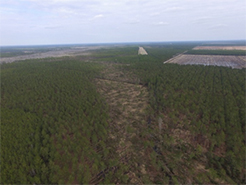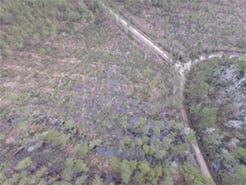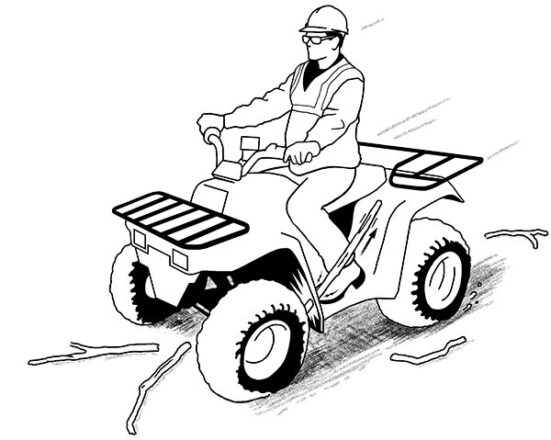Evaluating and Managing Storm-Damaged Forestland

Forest landowners are likely to have some amount of storm damage to their forest land at some point in time. Many articles are available to landowners and foresters on evaluation and salvage of storm-damaged areas, but fewer are available on practical salvage practices for loggers. Below are some tips for foresters and loggers when evaluating storm-damaged stands for salvage.
Safety First
Storm-damaged areas will be filled with leaning trees, broken tops, hung branches, and other overhead hazards. Trees are likely to be bent, held by other trees, root sprung, or otherwise placed under load. Trees loaded can rapidly spring back and cause injury or damage to equipment.
Before entering a storm-damaged area, assess potential hazards. Avoid entering storm-damaged areas unless necessary on foot. If data must be collected on damaged trees, use the minimum number of plots necessary to estimate damage.
Evaluate the Extent of Damage
Before considering salvage operations, evaluate the extent of the damaged area and the degree of damage to the impacted stands. Aerial surveys are often necessary to assess hurricane damage.

Tornado damage is usually confined to a pathway and can more easily be tracked and assessed from the ground. Use stand maps and photograph overlain by the storm path to make a reconnaissance plan. Map the damage and assess the feasibility of salvage harvesting.
Set Priorities for Salvage
Higher value products, particularly those to be sold for lumber or veneer, should be prioritized. This is particularly true if they are broken because the wood will stain quickly, particularly in warmer weather. Salvage candidates should be prioritized not only by the extent of the damage but by the value of the remaining volume, the feasibility of logging the site, the additional volume that may need to be added to make a viable sale, and the likelihood of pest invasion.
Harvesting Considerations
Use tracked feller bunchers with pivoting heads or processors where possible to increase felling flotation, safely fell broken or leaning trees, and feasibly cut wind thrown stems. Immediately following hurricane-damaged stands, soil saturation is likely, so ground flotation will be important. If enough volume is available, shovel logging may be feasible. Still, shovel logging will likely be made much more difficult because suitable material for the shovel road may be too broken to be usable.

Reforestation Considerations
Have a plan for managing unmerchantable debris caused by breakage and other damage. It may be necessary to create piles that can later be burned, or if markets are available, it may be possible for debris to be chipped and sold. In either case, consider debris management and its effect on reforestation.
FRA Resources on Salvage Harvesting Safety
Now that Spring has arrived and brought an increased threat of severe storms, this blog is a great forum to remind forest landowners to have a good plan in place if a salvage operation is required. FRA partnered with Forestry Mutual Insurance Company and the N.C. Association of Professional Loggers (now the Carolina Loggers Association) on producing a safety video, Storm Damage and Salvage Safety (09-A-6). This video, along with an accompanying Discussion Leader’s Guide (09-R-6), is available for purchase. The video emphasizes the importance of identifying and taking proper measures to reduce risk before beginning a salvage operation.

Mechanized equipment should be used whenever possible to assist in a salvage effort; however, the need for “boots on the ground” labor is often required.
This video is beneficial for educating chainsaw operators on proper cutting techniques to safely salvage tension wood, spring poles, etc. The ability to correctly identify incidents when wood is under compression, how to safely remove or eliminate tension, and where to stand while operating the saw are major points of emphasis covered in the video.

Additionally, several recent Technical Releases are an excellent resource for our members: Minnesota Loggers and Salvage Harvesting (19-R-14) and Wisconsin Windstorm Damage (19-R-26). A properly executed timber salvage harvesting operation is a great tool for immediately reducing financial loss following an unwelcomed event. Salvage harvesting is a slow and tedious process. Take your time and adhere to a well-devised plan. And always remember…Safety First!
For more information on dealing with forests damaged by storms:
https://www.forestpests.org/storm/
https://www.aces.edu/blog/topics/forestry/
https://bugwoodcloud.org/bugwood/productivity/
https://content.ces.ncsu.edu/decision-making-guidelines-for-storm-damaged-trees
https://www.ncforestservice.gov/managing_your_forest/

Reviewed by Clay Altizer, FRA Southwide Region Manager


